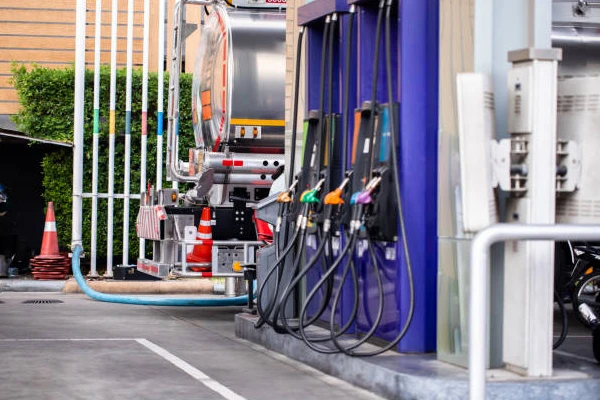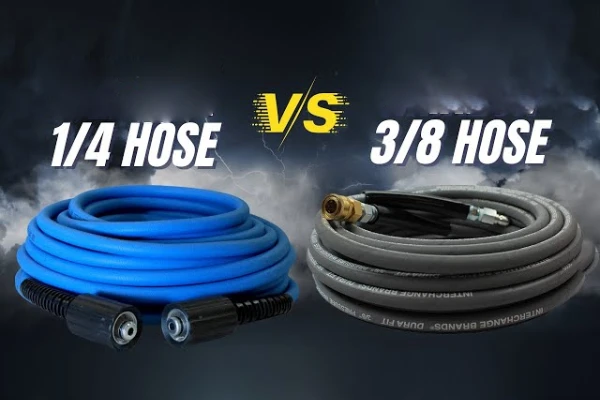Polyurethane hose, a versatile and resilient material, has carved a niche for itself across various industries and applications.
In this comprehensive exposition, we will delve into the multifaceted nature of polyurethane hose, exploring its composition, properties, diverse applications, benefits, and maintenance practices.
What Is Polyurethane Hose
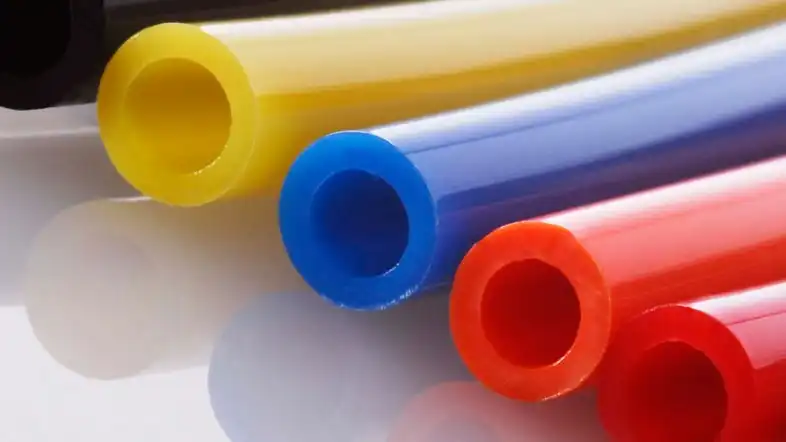
Polyurethane, a polymer composed of organic units linked by urethane, forms the foundation of polyurethane hose. This material’s chemical composition imparts remarkable flexibility, durability, and resistance to abrasion and tearing, making it an ideal choice for various hose applications. The unique molecular structure of polyurethane contributes to its outstanding mechanical properties, enabling it to withstand challenging environments and demanding usage scenarios.
What Is Polyurethane
Polyurethane is a versatile polymer composed of organic units linked by urethane groups. This material is known for its remarkable properties, including flexibility, durability, chemical resistance, and abrasion resistance.
Polyurethane is commonly used in a wide range of applications, such as flexible foam in mattresses and upholstery, rigid foam for insulation, adhesives, coatings, sealants, and elastomers for various industrial and consumer products. Its adaptability and diverse applications make polyurethane a valuable material in many industries.
Polyurethane Hose Vs TPU Hose
Here is a comparison table between Polyurethane Hoses and TPU (Thermoplastic Polyurethane) Hoses:
| Feature | Polyurethane Hose | TPU Hose |
|---|---|---|
| Flexibility | Good flexibility, but less than TPU | Excellent flexibility and conformability |
| Durability | Moderate durability, can be prone to cracking and abrasion | Highly durable, resistant to abrasion, kinking, and cracking |
| Chemical Resistance | Moderate resistance to chemicals and solvents | Excellent resistance to a wide range of chemicals and solvents |
| Temperature Range | Typically suitable for -40°C to 100°C (-40°F to 212°F) | Wide temperature range, typically -40°C to 150°C (-40°F to 302°F) |
| Pressure Rating | Moderate pressure rating, typically up to 300 psi | High pressure rating, typically up to 1,000 psi or more |
| FDA/Food-Grade Compliance | May require specialized formulations to meet food-grade requirements | Readily available in FDA-approved, food-grade, and pharmaceutical-grade options |
| Cost | Generally less expensive than TPU hoses | Slightly higher cost compared to standard polyurethane hoses |
| Applications | General industrial, automotive, and low-pressure fluid transfer | Automotive, industrial manufacturing, food and beverage, pharmaceutical, and high-pressure fluid transfer |
The key advantages of TPU hoses over standard polyurethane hoses include superior flexibility, durability, chemical resistance, temperature tolerance, and pressure rating. TPU hoses are also more readily available in specialized formulations for food-grade, pharmaceutical, and other regulated applications.
While TPU hoses may have a slightly higher initial cost, their enhanced performance and longevity often make them a more cost-effective solution in the long run, especially in demanding industrial and critical applications.
Polyurethane Hose Types
How many types of Polyurethane Hoses are there?
Polyurethane hoses come in a variety of types, each designed to meet specific application requirements. Here are some of the common types of polyurethane hoses:
Standard Polyurethane Hose:
This is the most basic type of polyurethane hose, offering good flexibility, abrasion resistance, and chemical compatibility.
Suitable for a wide range of applications, including pneumatic systems, fluid transfer, and light-duty industrial uses.
Reinforced Polyurethane Hose:
These hoses feature an additional reinforcement layer, such as a spiral wire or braided fabric, to provide enhanced strength and pressure resistance.
Ideal for high-pressure applications, hydraulic systems, and heavy-duty industrial environments.
Anti-Static Polyurethane Hose:
Designed to dissipate static electricity, these hoses are used in applications where there is a risk of static buildup, such as in explosive or flammable environments.
They help prevent the accumulation of static charge, reducing the potential for sparks or ignition.
Food-Grade Polyurethane Hose:
Formulated to meet strict food-contact standards, these hoses are suitable for use in the food and beverage industry.
They are resistant to chemicals, oils, and microbial growth, ensuring compliance with food safety regulations.
Temperature-Resistant Polyurethane Hose:
These hoses are designed to withstand high or low temperatures, depending on the application requirements.
They are often used in applications involving hot or cold fluids, or in environments with extreme temperature fluctuations.
Conductive Polyurethane Hose:
Conductive polyurethane hoses are designed to dissipate static electricity and provide a path for grounding.
They are commonly used in applications where there is a risk of static buildup, such as in the handling of flammable liquids or powders.
Transparent Polyurethane Hose:
These hoses feature a clear or translucent construction, allowing for visual inspection of the fluid flow.
They are often used in applications where monitoring the fluid condition or identifying potential issues is important.
The selection of the appropriate polyurethane hose type depends on the specific requirements of the application, including factors such as pressure, temperature, chemical exposure, and the need for specialized features like anti-static or food-grade properties.
Properties and Composition
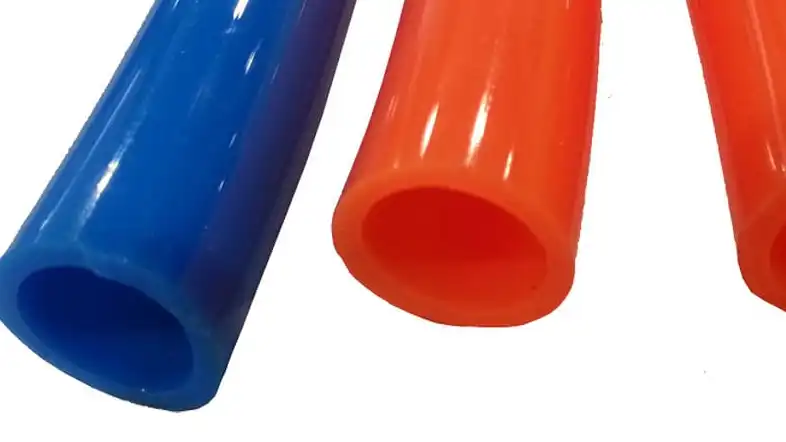
- Flexibility and Resilience: Polyurethane hose exhibits exceptional flexibility, allowing it to bend and maneuver without compromising its structural integrity. This inherent resilience makes it an excellent choice for applications that require both flexibility and durability.
- Abrasion Resistance: The abrasion-resistant nature of polyurethane hose sets it apart, enabling it to withstand friction and wear in rugged industrial environments. This property enhances the longevity and reliability of the hose in demanding applications.
- Chemical Compatibility: Polyurethane is compatible with a wide range of chemicals, oils, and solvents, making it suitable for applications where resistance to chemical exposure is crucial.
- Temperature Resistance: Polyurethane hose demonstrates remarkable resistance to temperature extremes, ensuring that it remains functional and reliable even in environments with fluctuating temperatures.
- Lightweight Construction: Compared to other materials, polyurethane hose is lightweight, offering ease of handling and transport without compromising its performance capabilities.
What is Polyurethane Hose Used For

Polyurethane hoses are utilized in various applications across different industries due to their unique properties and versatility.
Here are some common uses of polyurethane hoses:
Pneumatic Systems: Polyurethane hoses are commonly used in pneumatic systems for their flexibility, lightweight construction, and resistance to kinking. They are ideal for conveying compressed air in applications such as air tools, pneumatic machinery, and automated systems.
Hydraulic Systems: In hydraulic systems, polyurethane hoses are valued for their durability, abrasion resistance, and ability to withstand high pressure. These hoses are used to transmit hydraulic fluids and oils, making them essential components in hydraulic equipment and machinery.
Industrial Automation: Polyurethane hoses play a critical role in industrial automation applications, including robotics, conveying air, vacuum, or other gases. Their flexibility and chemical resistance make them suitable for a wide range of automated processes and equipment.
Fluid Transfer: Polyurethane hoses are widely employed for transferring fluids such as water, chemicals, oils, and other liquids. Their chemical compatibility, durability, and resistance to abrasion make them a preferred choice in industries requiring fluid transfer, such as manufacturing, agriculture, and automotive.
Vacuum Systems: Polyurethane hoses are used in vacuum systems for their ability to maintain vacuum pressure and resist collapsing under suction. They are commonly found in vacuum cleaner hoses, industrial vacuum systems, and laboratory equipment that require reliable vacuum suction.
Dust and Particle Extraction: Polyurethane hoses are utilized in dust and particle extraction systems to efficiently capture and transport dust, debris, and particles. These hoses are durable, flexible, and resistant to abrasion, making them suitable for industrial dust collection applications.
Chemical Transfer: Due to their chemical resistance, polyurethane hoses are utilized for the transfer of various chemicals and solvents. They can withstand exposure to a wide range of chemicals, making them essential in industries where chemical compatibility is crucial.
Lightweight Conduits: Polyurethane hoses are favored for their lightweight construction, which makes them easy to handle and transport. They are used in applications where weight reduction is important, such as portable equipment, mobile machinery, and construction tools.
Benefits of Polyurethane Hose
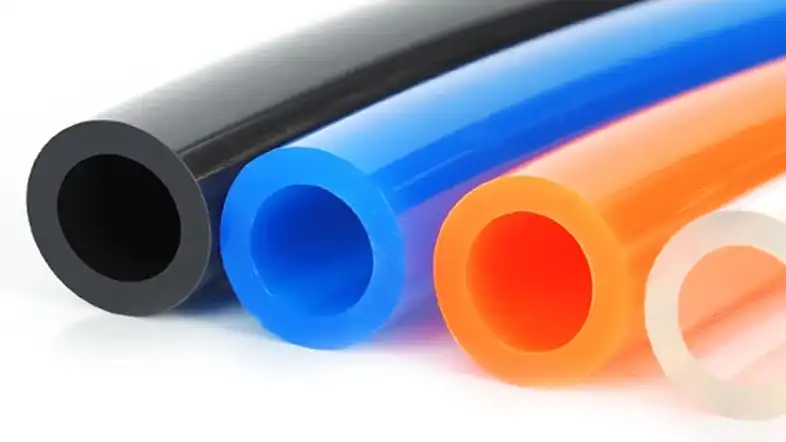
These benefits collectively position polyurethane hoses as essential components in industries requiring reliable, flexible, and durable hose solutions for a wide range of applications and environments.
Flexibility: Polyurethane hoses exhibit exceptional flexibility, allowing for easy maneuverability in tight spaces. This characteristic makes them suitable for applications where bending and movement are required without compromising the integrity of the hose.
Abrasion Resistance: These hoses are highly resistant to abrasion, making them long-lasting and well-suited for rugged industrial environments. Their ability to withstand wear and tear contributes to reduced maintenance and replacement costs.
Chemical Compatibility: Polyurethane hoses are compatible with a wide range of chemicals, oils, and solvents, making them ideal for applications where exposure to various substances is a concern. This chemical resistance enhances their reliability in diverse industrial settings.
Temperature Resistance: The temperature resistance of polyurethane hoses allows them to maintain their functionality and structural integrity across a broad range of temperatures, ensuring consistent performance in fluctuating environmental conditions.
Lightweight Construction: With their lightweight design, polyurethane hoses are easy to handle and transport, contributing to greater usability and convenience in various applications.
Kink Resistance: These hoses resist kinking, ensuring consistent flow and performance even in challenging installation scenarios, which can contribute to improved operational efficiency.
Diverse Applications: Polyurethane hoses find use in a wide array of applications, including pneumatic systems, hydraulic systems, industrial automation, fluid transfer, vacuum systems, dust extraction, chemical transfer, and as lightweight conduits, showcasing their versatility.
Longevity and Durability: The robustness and resistance to wear and tear make polyurethane hoses durable and long-lasting, contributing to reduced downtime and maintenance costs.
Ease of Maintenance: Polyurethane hoses are relatively easy to maintain, requiring periodic visual inspections, cleaning, and storage in line with manufacturer recommendations to ensure their optimal performance and longevity.manufacturer rec
These benefits collectively position polyurethane hoses as essential components in industries requiring reliable, flexible, and durable hose solutions for a wide range of applications and environments.
Maintenance and Care for Polyurethane Hose
Proper maintenance and care are essential for ensuring the longevity and optimal performance of polyurethane hoses. Here are some key considerations for maintaining and caring for polyurethane hoses:
Regular Inspections:
- Conduct periodic visual inspections of the polyurethane hose for signs of wear, damage, or deterioration, such as cracks, abrasions, or bulges.
- Check for any leaks or fluid seepage, which could indicate a problem with the hose.
- Examine the hose connections and fittings for any looseness or signs of wear.
Cleaning and Storage:
- Clean the polyurethane hose according to the manufacturer‘s recommendations, using appropriate cleaning agents and methods.manufacturer‘s recommendations, using appropri
- Ensure the hose is thoroughly dried before storage to prevent the buildup of moisture or contaminants.
- Store the polyurethane hose in a cool, dry place, away from direct sunlight, heat sources, and ozone-generating equipment.
- Avoid kinking or crushing the hose during storage, as this can compromise its structural integrity.
Avoiding Misuse:
- Ensure the polyurethane hose is used within its specified pressure, temperature, and chemical compatibility limits.
- Avoid exposing the hose to excessive bending, twisting, or stretching, as this can lead to premature wear and failure.
- Protect the hose from abrasion, cuts, or punctures by routing it away from sharp edges or moving components.
Replacement Policy:
- Establish a proactive replacement policy for polyurethane hoses based on factors such as usage, environmental conditions, and observed wear and tear.
- Replace the hose before it reaches the end of its service life to prevent unexpected failures and downtime.
- Follow the manufacturer‘s recommendations for the hose’s maximum service life or replacement intervals.
Installation and Handling:
- Ensure proper installation techniques, such as avoiding over-tightening of fittings or excessive bending of the hose.
- Handle the polyurethane hose with care during installation and maintenance to prevent damage.
- Avoid exposing the hose to excessive tension, compression, or torsional forces, which can compromise its performance.
Compatibility Considerations:
- Verify the compatibility of the polyurethane hose with the fluids, gases, or environments it will be exposed to.
- Consult the manufacturer‘s recommendations or technical data to ensure the hose is suitable for the specific application.
By following these maintenance and care practices, you can maximize the lifespan and reliability of polyurethane hoses, ensuring their optimal performance and minimizing the risk of unexpected failures or downtime in your industrial or commercial applications.
Contact Us for Your Polyurethane Hose Needs
If you’re interested in learning more about the benefits and applications of polyurethane hoses, or if you need assistance in selecting the right hose for your specific requirements, we encourage you to reach out to our team of experts.
Our knowledgeable professionals are dedicated to providing personalized solutions and guiding you through the selection process to ensure you find the perfect polyurethane hose for your industrial, commercial, or specialized needs.
Feel free to contact us at any time by phone, email, or through our website. We’re here to answer your questions, provide technical support, and help you unlock the full potential of polyurethane hoses in your operations.
Take the first step towards a more reliable, efficient, and durable hose solution. Connect with us today and let us help you harness the power of polyurethane hose technology.



